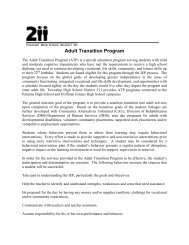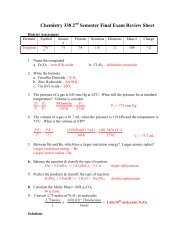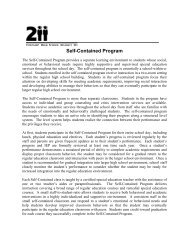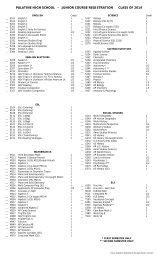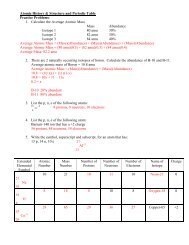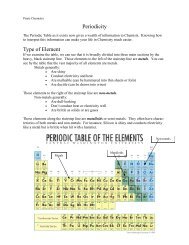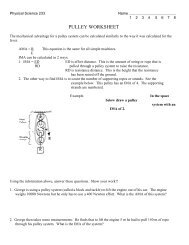Ch 45 PPT
Ch 45 PPT
Ch 45 PPT
You also want an ePaper? Increase the reach of your titles
YUMPU automatically turns print PDFs into web optimized ePapers that Google loves.
<strong>Ch</strong>apter <strong>45</strong><br />
Hormones and the<br />
Endocrine System<br />
PowerPoint ® Lecture Presentations for<br />
Biology<br />
Eighth Edition<br />
Neil Campbell and Jane Reece<br />
Lectures by <strong>Ch</strong>ris Romero, updated by Erin Barley with contributions from Joan Sharp<br />
Copyright © 2008 Pearson Education, Inc., publishing as Pearson Benjamin Cummings
Overview: The Body’s Long-Distance Regulators<br />
• Animal hormones are chemical signals that<br />
are secreted into the circulatory system and<br />
communicate regulatory messages within the<br />
body<br />
• Hormones reach all parts of the body, but only<br />
target cells are equipped to respond<br />
• Insect metamorphosis is regulated by<br />
hormones<br />
Copyright © 2008 Pearson Education, Inc., publishing as Pearson Benjamin Cummings
• Two systems coordinate communication<br />
throughout the body: the endocrine system and<br />
the nervous system<br />
• The endocrine system secretes hormones<br />
that coordinate slower but longer-acting<br />
responses including reproduction,<br />
development, energy metabolism, growth, and<br />
behavior<br />
• The nervous system conveys high-speed<br />
electrical signals along specialized cells called<br />
neurons; these signals regulate other cells<br />
Copyright © 2008 Pearson Education, Inc., publishing as Pearson Benjamin Cummings
Fig. <strong>45</strong>-1
Fig. <strong>45</strong>-UN1
Concept <strong>45</strong>.1: Hormones and other signaling<br />
molecules bind to target receptors, triggering<br />
specific response pathways<br />
• <strong>Ch</strong>emical signals bind to receptor proteins on<br />
target cells<br />
• Only target cells respond to the signal<br />
Copyright © 2008 Pearson Education, Inc., publishing as Pearson Benjamin Cummings
Types of Secreted Signaling Molecules<br />
• Secreted chemical signals include<br />
– Hormones<br />
– Local regulators<br />
– Neurotransmitters<br />
– Neurohormones<br />
– Pheromones<br />
Copyright © 2008 Pearson Education, Inc., publishing as Pearson Benjamin Cummings
Hormones<br />
• Endocrine signals (hormones) are secreted into<br />
extracellular fluids and travel via the<br />
bloodstream<br />
• Endocrine glands are ductless and secrete<br />
hormones directly into surrounding fluid<br />
• Hormones mediate responses to environmental<br />
stimuli and regulate growth, development, and<br />
reproduction<br />
Copyright © 2008 Pearson Education, Inc., publishing as Pearson Benjamin Cummings
Fig. <strong>45</strong>-2<br />
Blood<br />
vessel<br />
Response<br />
(a) Endocrine signaling<br />
Response<br />
(b) Paracrine signaling<br />
Response<br />
(c) Autocrine signaling<br />
Synapse<br />
Neuron<br />
Response<br />
(d) Synaptic signaling<br />
Neurosecretory<br />
cell<br />
Blood<br />
vessel<br />
Response<br />
(e) Neuroendocrine signaling
• Exocrine glands have ducts and secrete<br />
substances onto body surfaces or into body<br />
cavities (for example, tear ducts)<br />
Copyright © 2008 Pearson Education, Inc., publishing as Pearson Benjamin Cummings
Local Regulators<br />
• Local regulators are chemical signals that<br />
travel over short distances by diffusion<br />
• Local regulators help regulate blood pressure,<br />
nervous system function, and reproduction<br />
• Local regulators are divided into two types<br />
– Paracrine signals act on cells near the<br />
secreting cell<br />
– Autocrine signals act on the secreting cell<br />
itself<br />
Copyright © 2008 Pearson Education, Inc., publishing as Pearson Benjamin Cummings
Fig. <strong>45</strong>-2a<br />
Blood<br />
vessel<br />
Response<br />
(a) Endocrine signaling<br />
Response<br />
(b) Paracrine signaling<br />
Response<br />
(c) Autocrine signaling
Neurotransmitters and Neurohormones<br />
• Neurons (nerve cells) contact target cells at<br />
synapses<br />
• At synapses, neurons often secrete chemical<br />
signals called neurotransmitters that diffuse a<br />
short distance to bind to receptors on the target<br />
cell<br />
• Neurotransmitters play a role in sensation,<br />
memory, cognition, and movement<br />
Copyright © 2008 Pearson Education, Inc., publishing as Pearson Benjamin Cummings
Fig. <strong>45</strong>-2b<br />
Synapse<br />
Neuron<br />
Response<br />
(d) Synaptic signaling<br />
Neurosecretory<br />
cell<br />
Blood<br />
vessel<br />
Response<br />
(e) Neuroendocrine signaling
• Neurohormones are a class of hormones that<br />
originate from neurons in the brain and diffuse<br />
through the bloodstream<br />
Copyright © 2008 Pearson Education, Inc., publishing as Pearson Benjamin Cummings
Pheromones<br />
• Pheromones are chemical signals that are<br />
released from the body and used to<br />
communicate with other individuals in the<br />
species<br />
• Pheromones mark trails to food sources, warn<br />
of predators, and attract potential mates<br />
Copyright © 2008 Pearson Education, Inc., publishing as Pearson Benjamin Cummings
<strong>Ch</strong>emical Classes of Hormones<br />
• Three major classes of molecules function as<br />
hormones in vertebrates:<br />
– Polypeptides (proteins and peptides)<br />
– Amines derived from amino acids<br />
– Steroid hormones<br />
Copyright © 2008 Pearson Education, Inc., publishing as Pearson Benjamin Cummings
• Lipid-soluble hormones (steroid hormones)<br />
pass easily through cell membranes, while<br />
water-soluble hormones (polypeptides and<br />
amines) do not<br />
• The solubility of a hormone correlates with the<br />
location of receptors inside or on the surface of<br />
target cells<br />
Copyright © 2008 Pearson Education, Inc., publishing as Pearson Benjamin Cummings
Fig. <strong>45</strong>-3<br />
Water-soluble<br />
Lipid-soluble<br />
Polypeptide:<br />
Insulin<br />
0.8 nm<br />
Steroid:<br />
Cortisol<br />
Amine:<br />
Epinephrine<br />
Amine:<br />
Thyroxine
Hormone Receptor Location: Scientific Inquiry<br />
• In the 1960s, researchers studied the<br />
accumulation of radioactive steroid hormones in<br />
rat tissue<br />
• These hormones accumulated only in target cells<br />
that were responsive to the hormones<br />
• These experiments led to the hypothesis that<br />
receptors for the steroid hormones are located<br />
inside the target cells<br />
• Further studies have confirmed that receptors for<br />
lipid-soluble hormones such as steroids are<br />
located inside cells<br />
Copyright © 2008 Pearson Education, Inc., publishing as Pearson Benjamin Cummings
• Researchers hypothesized that receptors for<br />
water-soluble hormones would be located on<br />
the cell surface<br />
• They injected a water-soluble hormone into the<br />
tissues of frogs<br />
• The hormone triggered a response only when it<br />
was allowed to bind to cell surface receptors<br />
• This confirmed that water-soluble receptors<br />
were on the cell surface<br />
Copyright © 2008 Pearson Education, Inc., publishing as Pearson Benjamin Cummings
Fig. <strong>45</strong>-4<br />
RESULTS<br />
MSH injected into melanocyte<br />
Melanocyte<br />
with melanosomes<br />
(black dots)<br />
Melanosomes<br />
do not disperse<br />
Nucleus<br />
Melanosomes<br />
disperse<br />
MSH injected into interstitial fluid (blue)
Cellular Response Pathways<br />
• Water and lipid soluble hormones differ in their<br />
paths through a body<br />
• Water-soluble hormones are secreted by<br />
exocytosis, travel freely in the bloodstream,<br />
and bind to cell-surface receptors<br />
• Lipid-soluble hormones diffuse across cell<br />
membranes, travel in the bloodstream bound to<br />
transport proteins, and diffuse through the<br />
membrane of target cells<br />
Copyright © 2008 Pearson Education, Inc., publishing as Pearson Benjamin Cummings
• Signaling by any of these hormones involves<br />
three key events:<br />
– Reception<br />
– Signal transduction<br />
– Response<br />
Copyright © 2008 Pearson Education, Inc., publishing as Pearson Benjamin Cummings
Fig. <strong>45</strong>-5-1<br />
Watersoluble<br />
hormone<br />
Fat-soluble<br />
hormone<br />
Signal receptor<br />
Transport<br />
protein<br />
TARGET<br />
CELL<br />
Signal<br />
receptor<br />
(a)<br />
NUCLEUS<br />
(b)
Fig. <strong>45</strong>-5-2<br />
Watersoluble<br />
hormone<br />
Fat-soluble<br />
hormone<br />
Signal receptor<br />
Transport<br />
protein<br />
TARGET<br />
CELL<br />
OR<br />
Signal<br />
receptor<br />
Cytoplasmic<br />
response<br />
Gene<br />
regulation<br />
Cytoplasmic<br />
response<br />
Gene<br />
regulation<br />
(a) NUCLEUS (b)
Pathway for Water-Soluble Hormones<br />
• Binding of a hormone to its receptor initiates a<br />
signal transduction pathway leading to<br />
responses in the cytoplasm, enzyme activation,<br />
or a change in gene expression<br />
Animation: Water-Soluble Hormone<br />
Copyright © 2008 Pearson Education, Inc., publishing as Pearson Benjamin Cummings
• The hormone epinephrine has multiple effects<br />
in mediating the body’s response to short-term<br />
stress<br />
• Epinephrine binds to receptors on the plasma<br />
membrane of liver cells<br />
• This triggers the release of messenger<br />
molecules that activate enzymes and result in<br />
the release of glucose into the bloodstream<br />
Copyright © 2008 Pearson Education, Inc., publishing as Pearson Benjamin Cummings
Fig. <strong>45</strong>-6-1<br />
Epinephrine<br />
G protein<br />
Adenylyl<br />
cyclase<br />
G protein-coupled<br />
receptor<br />
GTP<br />
ATP<br />
cAMP<br />
Second<br />
messenger
Fig. <strong>45</strong>-6-2<br />
Epinephrine<br />
G protein<br />
Adenylyl<br />
cyclase<br />
G protein-coupled<br />
receptor<br />
GTP<br />
ATP<br />
cAMP<br />
Second<br />
messenger<br />
Inhibition of<br />
glycogen synthesis<br />
Protein<br />
kinase A<br />
Promotion of<br />
glycogen breakdown
Pathway for Lipid-Soluble Hormones<br />
• The response to a lipid-soluble hormone is<br />
usually a change in gene expression<br />
• Steroids, thyroid hormones, and the hormonal<br />
form of vitamin D enter target cells and bind to<br />
protein receptors in the cytoplasm or nucleus<br />
• Protein-receptor complexes then act as<br />
transcription factors in the nucleus, regulating<br />
transcription of specific genes<br />
Animation: Lipid-Soluble Hormone<br />
Copyright © 2008 Pearson Education, Inc., publishing as Pearson Benjamin Cummings
Fig. <strong>45</strong>-7-1<br />
Hormone<br />
(estradiol)<br />
Estradiol<br />
(estrogen)<br />
receptor<br />
Plasma<br />
membrane<br />
Hormone-receptor<br />
complex
Fig. <strong>45</strong>-7-2<br />
Hormone<br />
(estradiol)<br />
Estradiol<br />
(estrogen)<br />
receptor<br />
Plasma<br />
membrane<br />
Hormone-receptor<br />
complex<br />
DNA<br />
mRNA<br />
for vitellogenin<br />
Vitellogenin
Multiple Effects of Hormones<br />
• The same hormone may have different effects<br />
on target cells that have<br />
– Different receptors for the hormone<br />
– Different signal transduction pathways<br />
– Different proteins for carrying out the response<br />
• A hormone can also have different effects in<br />
different species<br />
Copyright © 2008 Pearson Education, Inc., publishing as Pearson Benjamin Cummings
Fig. <strong>45</strong>-8-1<br />
Same receptors but different<br />
intracellular proteins (not shown)<br />
Epinephrine<br />
β receptor<br />
Epinephrine<br />
β receptor<br />
Glycogen<br />
deposits<br />
Glycogen<br />
breaks down<br />
and glucose<br />
is released.<br />
Vessel<br />
dilates.<br />
(a) Liver cell<br />
(b) Skeletal muscle<br />
blood vessel
Fig. <strong>45</strong>-8-2<br />
Same receptors but different<br />
intracellular proteins (not shown)<br />
Different receptors<br />
Epinephrine<br />
β receptor<br />
Glycogen<br />
deposits<br />
Epinephrine<br />
β receptor<br />
Epinephrine<br />
α receptor<br />
Glycogen<br />
breaks down<br />
and glucose<br />
is released.<br />
Vessel<br />
dilates.<br />
Vessel<br />
constricts.<br />
(a) Liver cell<br />
(b) Skeletal muscle<br />
blood vessel<br />
(c) Intestinal blood<br />
vessel
Fig. <strong>45</strong>-9<br />
(a)<br />
(b)
Fig. <strong>45</strong>-9a<br />
(a)
Fig. <strong>45</strong>-9b<br />
(b)
Signaling by Local Regulators<br />
• In paracrine signaling, nonhormonal chemical<br />
signals called local regulators elicit responses<br />
in nearby target cells<br />
• Types of local regulators:<br />
– Cytokines and growth factors<br />
– Nitric oxide (NO)<br />
– Prostaglandins<br />
Copyright © 2008 Pearson Education, Inc., publishing as Pearson Benjamin Cummings
• Prostaglandins help regulate aggregation of<br />
platelets, an early step in formation of blood<br />
clots<br />
Copyright © 2008 Pearson Education, Inc., publishing as Pearson Benjamin Cummings
Concept <strong>45</strong>.2: Negative feedback and antagonistic<br />
hormone pairs are common features of the<br />
endocrine system<br />
• Hormones are assembled into regulatory<br />
pathways<br />
Copyright © 2008 Pearson Education, Inc., publishing as Pearson Benjamin Cummings
Fig. <strong>45</strong>-10<br />
Major endocrine glands:<br />
Hypothalamus<br />
Pineal gland<br />
Pituitary gland<br />
Thyroid gland<br />
Parathyroid glands<br />
Adrenal<br />
glands<br />
Organs containing<br />
endocrine cells:<br />
Thymus<br />
Heart<br />
Liver<br />
Stomach<br />
Testes<br />
Pancreas<br />
Kidney<br />
Ovaries<br />
Kidney<br />
Small<br />
intestine
Simple Hormone Pathways<br />
• Hormones are released from an endocrine cell,<br />
travel through the bloodstream, and interact<br />
with the receptor or a target cell to cause a<br />
physiological response<br />
Copyright © 2008 Pearson Education, Inc., publishing as Pearson Benjamin Cummings
Fig. <strong>45</strong>-11<br />
–<br />
Pathway<br />
Stimulus<br />
Example<br />
Low pH in<br />
duodenum<br />
Endocrine<br />
cell<br />
Blood<br />
vessel<br />
S cells of duodenum<br />
secrete secretin ( )<br />
Target<br />
cells<br />
Pancreas<br />
Response<br />
Bicarbonate release
• A negative feedback loop inhibits a response<br />
by reducing the initial stimulus<br />
• Negative feedback regulates many hormonal<br />
pathways involved in homeostasis<br />
Copyright © 2008 Pearson Education, Inc., publishing as Pearson Benjamin Cummings
Insulin and Glucagon: Control of Blood Glucose<br />
• Insulin and glucagon are antagonistic<br />
hormones that help maintain glucose<br />
homeostasis<br />
• The pancreas has clusters of endocrine cells<br />
called islets of Langerhans with alpha cells<br />
that produce glucagon and beta cells that<br />
produce insulin<br />
Copyright © 2008 Pearson Education, Inc., publishing as Pearson Benjamin Cummings
Fig. <strong>45</strong>-12-1<br />
Insulin<br />
Beta cells of<br />
pancreas<br />
release insulin<br />
into the blood.<br />
STIMULUS:<br />
Blood glucose level<br />
rises.<br />
Homeostasis:<br />
Blood glucose level<br />
(about 90 mg/100 mL)
Fig. <strong>45</strong>-12-2<br />
Body cells<br />
take up more<br />
glucose.<br />
Insulin<br />
Beta cells of<br />
pancreas<br />
release insulin<br />
into the blood.<br />
Liver takes<br />
up glucose<br />
and stores it<br />
as glycogen.<br />
Blood glucose<br />
level declines.<br />
STIMULUS:<br />
Blood glucose level<br />
rises.<br />
Homeostasis:<br />
Blood glucose level<br />
(about 90 mg/100 mL)
Fig. <strong>45</strong>-12-3<br />
Homeostasis:<br />
Blood glucose level<br />
(about 90 mg/100 mL)<br />
STIMULUS:<br />
Blood glucose level<br />
falls.<br />
Alpha cells of pancreas<br />
release glucagon.<br />
Glucagon
Fig. <strong>45</strong>-12-4<br />
Homeostasis:<br />
Blood glucose level<br />
(about 90 mg/100 mL)<br />
Blood glucose<br />
level rises.<br />
STIMULUS:<br />
Blood glucose level<br />
falls.<br />
Alpha cells of pancreas<br />
release glucagon.<br />
Liver breaks<br />
down glycogen<br />
and releases<br />
glucose.<br />
Glucagon
Fig. <strong>45</strong>-12-5<br />
Body cells<br />
take up more<br />
glucose.<br />
Insulin<br />
Beta cells of<br />
pancreas<br />
release insulin<br />
into the blood.<br />
Liver takes<br />
up glucose<br />
and stores it<br />
as glycogen.<br />
Blood glucose<br />
level declines.<br />
STIMULUS:<br />
Blood glucose level<br />
rises.<br />
Homeostasis:<br />
Blood glucose level<br />
(about 90 mg/100 mL)<br />
Blood glucose<br />
level rises.<br />
STIMULUS:<br />
Blood glucose level<br />
falls.<br />
Alpha cells of pancreas<br />
release glucagon.<br />
Liver breaks<br />
down glycogen<br />
and releases<br />
glucose.<br />
Glucagon
Target Tissues for Insulin and Glucagon<br />
• Insulin reduces blood glucose levels by<br />
– Promoting the cellular uptake of glucose<br />
– Slowing glycogen breakdown in the liver<br />
– Promoting fat storage<br />
Copyright © 2008 Pearson Education, Inc., publishing as Pearson Benjamin Cummings
• Glucagon increases blood glucose levels by<br />
– Stimulating conversion of glycogen to glucose<br />
in the liver<br />
– Stimulating breakdown of fat and protein into<br />
glucose<br />
Copyright © 2008 Pearson Education, Inc., publishing as Pearson Benjamin Cummings
Diabetes Mellitus<br />
• Diabetes mellitus is perhaps the best-known<br />
endocrine disorder<br />
• It is caused by a deficiency of insulin or a<br />
decreased response to insulin in target tissues<br />
• It is marked by elevated blood glucose levels<br />
Copyright © 2008 Pearson Education, Inc., publishing as Pearson Benjamin Cummings
• Type I diabetes mellitus (insulin-dependent) is<br />
an autoimmune disorder in which the immune<br />
system destroys pancreatic beta cells<br />
• Type II diabetes mellitus (non-insulindependent)<br />
involves insulin deficiency or<br />
reduced response of target cells due to change<br />
in insulin receptors<br />
Copyright © 2008 Pearson Education, Inc., publishing as Pearson Benjamin Cummings
Concept <strong>45</strong>.3: The endocrine and nervous systems act<br />
individually and together in regulating animal<br />
physiology<br />
• Signals from the nervous system initiate and<br />
regulate endocrine signals<br />
Copyright © 2008 Pearson Education, Inc., publishing as Pearson Benjamin Cummings
Coordination of Endocrine and Nervous Systems<br />
in Invertebrates<br />
• In insects, molting and development are<br />
controlled by a combination of hormones:<br />
– A brain hormone stimulates release of<br />
ecdysone from the prothoracic glands<br />
– Juvenile hormone promotes retention of larval<br />
characteristics<br />
– Ecdysone promotes molting (in the presence of<br />
juvenile hormone) and development (in the<br />
absence of juvenile hormone) of adult<br />
characteristics<br />
Copyright © 2008 Pearson Education, Inc., publishing as Pearson Benjamin Cummings
Fig. <strong>45</strong>-13-1<br />
Brain<br />
Neurosecretory cells<br />
PTTH<br />
Corpus cardiacum<br />
Corpus allatum<br />
Prothoracic<br />
gland<br />
Ecdysone<br />
Juvenile<br />
hormone<br />
(JH)<br />
EARLY<br />
LARVA
Fig. <strong>45</strong>-13-2<br />
Brain<br />
Neurosecretory cells<br />
PTTH<br />
Corpus cardiacum<br />
Corpus allatum<br />
Prothoracic<br />
gland<br />
Ecdysone<br />
Juvenile<br />
hormone<br />
(JH)<br />
EARLY<br />
LARVA<br />
LATER<br />
LARVA
Fig. <strong>45</strong>-13-3<br />
Brain<br />
Neurosecretory cells<br />
PTTH<br />
Corpus cardiacum<br />
Corpus allatum<br />
Prothoracic<br />
gland<br />
Low<br />
JH<br />
Ecdysone<br />
Juvenile<br />
hormone<br />
(JH)<br />
EARLY<br />
LARVA<br />
LATER<br />
LARVA PUPA ADULT
Coordination of Endocrine and Nervous Systems<br />
in Vertebrates<br />
• The hypothalamus receives information from<br />
the nervous system and initiates responses<br />
through the endocrine system<br />
• Attached to the hypothalamus is the pituitary<br />
gland composed of the posterior pituitary and<br />
anterior pituitary<br />
Copyright © 2008 Pearson Education, Inc., publishing as Pearson Benjamin Cummings
• The posterior pituitary stores and secretes<br />
hormones that are made in the hypothalamus<br />
• The anterior pituitary makes and releases<br />
hormones under regulation of the<br />
hypothalamus<br />
Copyright © 2008 Pearson Education, Inc., publishing as Pearson Benjamin Cummings
Fig. <strong>45</strong>-14<br />
Pineal<br />
gland<br />
Cerebellum<br />
Spinal cord<br />
Cerebrum<br />
Thalamus<br />
Hypothalamus<br />
Pituitary<br />
gland<br />
Hypothalamus<br />
Posterior<br />
pituitary<br />
Anterior<br />
pituitary
Table <strong>45</strong>-1
Table <strong>45</strong>-1a
Table <strong>45</strong>-1b
Table <strong>45</strong>-1c
Table <strong>45</strong>-1d
Posterior Pituitary Hormones<br />
• The two hormones released from the posterior<br />
pituitary act directly on nonendocrine tissues<br />
Copyright © 2008 Pearson Education, Inc., publishing as Pearson Benjamin Cummings
Fig. <strong>45</strong>-15<br />
Hypothalamus<br />
Neurosecretory<br />
cells of the<br />
hypothalamus<br />
Axon<br />
Posterior<br />
pituitary<br />
Anterior<br />
pituitary<br />
HORMONE<br />
ADH<br />
Oxytocin<br />
TARGET<br />
Kidney tubules<br />
Mammary glands,<br />
uterine muscles
• Oxytocin induces uterine contractions and the<br />
release of milk<br />
• Suckling sends a message to the<br />
hypothalamus via the nervous system to<br />
release oxytocin, which further stimulates the<br />
milk glands<br />
• This is an example of positive feedback,<br />
where the stimulus leads to an even greater<br />
response<br />
• Antidiuretic hormone (ADH) enhances water<br />
reabsorption in the kidneys<br />
Copyright © 2008 Pearson Education, Inc., publishing as Pearson Benjamin Cummings
Fig. <strong>45</strong>-16<br />
Pathway<br />
Example<br />
+<br />
Stimulus<br />
Suckling<br />
Hypothalamus/<br />
posterior pituitary<br />
Sensory<br />
neuron<br />
Positive feedback<br />
Neurosecretory<br />
cell<br />
Blood<br />
vessel<br />
Posterior pituitary<br />
secretes oxytocin ( )<br />
Target<br />
cells<br />
Smooth muscle in<br />
breasts<br />
Response<br />
Milk release
Anterior Pituitary Hormones<br />
• Hormone production in the anterior pituitary is<br />
controlled by releasing and inhibiting hormones<br />
from the hypothalamus<br />
• For example, the production of thyrotropin<br />
releasing hormone (TRH) in the hypothalamus<br />
stimulates secretion of the thyroid stimulating<br />
hormone (TSH) from the anterior pituitary<br />
Copyright © 2008 Pearson Education, Inc., publishing as Pearson Benjamin Cummings
Fig. <strong>45</strong>-17<br />
Tropic effects only:<br />
FSH<br />
LH<br />
TSH<br />
ACTH<br />
Neurosecretory cells<br />
of the hypothalamus<br />
Nontropic effects only:<br />
Prolactin<br />
MSH<br />
Nontropic and tropic effects:<br />
GH<br />
Hypothalamic<br />
releasing and<br />
inhibiting<br />
hormones<br />
Posterior pituitary<br />
Portal vessels<br />
Endocrine cells of<br />
the anterior pituitary<br />
Pituitary hormones<br />
HORMONE<br />
FSH and LH<br />
TSH<br />
ACTH Prolactin MSH GH<br />
TARGET<br />
Testes or<br />
ovaries<br />
Thyroid<br />
Adrenal<br />
cortex<br />
Mammary<br />
glands<br />
Melanocytes<br />
Liver, bones,<br />
other tissues
Hormone Cascade Pathways<br />
• A hormone can stimulate the release of a<br />
series of other hormones, the last of which<br />
activates a nonendocrine target cell; this is<br />
called a hormone cascade pathway<br />
• The release of thyroid hormone results from a<br />
hormone cascade pathway involving the<br />
hypothalamus, anterior pituitary, and thyroid<br />
gland<br />
• Hormone cascade pathways are usually<br />
regulated by negative feedback<br />
Copyright © 2008 Pearson Education, Inc., publishing as Pearson Benjamin Cummings
Fig. <strong>45</strong>-18-1<br />
Pathway<br />
Example<br />
Stimulus<br />
Cold<br />
Sensory<br />
neuron<br />
Neurosecretory<br />
cell<br />
Hypothalamus secretes<br />
thyrotropin-releasing<br />
hormone (TRH )<br />
Blood<br />
vessel
Fig. <strong>45</strong>-18-2<br />
Pathway<br />
Example<br />
+<br />
Stimulus<br />
Cold<br />
Sensory<br />
neuron<br />
Neurosecretory<br />
cell<br />
Hypothalamus secretes<br />
thyrotropin-releasing<br />
hormone (TRH )<br />
Blood<br />
vessel<br />
Anterior pituitary secretes<br />
thyroid-stimulating<br />
hormone (TSH<br />
or thyrotropin )
Fig. <strong>45</strong>-18-3<br />
Pathway<br />
Example<br />
Stimulus<br />
Cold<br />
–<br />
Sensory<br />
neuron<br />
Neurosecretory<br />
cell<br />
Hypothalamus secretes<br />
thyrotropin-releasing<br />
hormone (TRH )<br />
Blood<br />
vessel<br />
Negative feedback<br />
–<br />
Anterior pituitary secretes<br />
thyroid-stimulating<br />
hormone (TSH<br />
or thyrotropin )<br />
Thyroid gland secretes<br />
thyroid hormone<br />
(T 3 and T 4 )<br />
Target<br />
cells<br />
Body tissues<br />
Response<br />
Increased cellular<br />
metabolism
Tropic Hormones<br />
• A tropic hormone regulates the function of<br />
endocrine cells or glands<br />
• The four strictly tropic hormones are<br />
– Thyroid-stimulating hormone (TSH)<br />
– Follicle-stimulating hormone (FSH)<br />
– Luteinizing hormone (LH)<br />
– Adrenocorticotropic hormone (ACTH)<br />
Copyright © 2008 Pearson Education, Inc., publishing as Pearson Benjamin Cummings
Nontropic Hormones<br />
• Nontropic hormones target nonendocrine<br />
tissues<br />
• Nontropic hormones produced by the anterior<br />
pituitary are<br />
– Prolactin (PRL)<br />
– Melanocyte-stimulating hormone (MSH)<br />
Copyright © 2008 Pearson Education, Inc., publishing as Pearson Benjamin Cummings
• Prolactin stimulates lactation in mammals but<br />
has diverse effects in different vertebrates<br />
• MSH influences skin pigmentation in some<br />
vertebrates and fat metabolism in mammals<br />
Copyright © 2008 Pearson Education, Inc., publishing as Pearson Benjamin Cummings
Growth Hormone<br />
• Growth hormone (GH) is secreted by the<br />
anterior pituitary gland and has tropic and<br />
nontropic actions<br />
• It promotes growth directly and has diverse<br />
metabolic effects<br />
• It stimulates production of growth factors<br />
• An excess of GH can cause gigantism, while a<br />
lack of GH can cause dwarfism<br />
Copyright © 2008 Pearson Education, Inc., publishing as Pearson Benjamin Cummings
Concept <strong>45</strong>.4: Endocrine glands respond to diverse<br />
stimuli in regulating metabolism, homeostasis,<br />
development, and behavior<br />
• Endocrine signaling regulates metabolism,<br />
homeostasis, development, and behavior<br />
Copyright © 2008 Pearson Education, Inc., publishing as Pearson Benjamin Cummings
Thyroid Hormone: Control of Metabolism and<br />
Development<br />
• The thyroid gland consists of two lobes on the<br />
ventral surface of the trachea<br />
• It produces two iodine-containing hormones:<br />
triiodothyronine (T 3 ) and thyroxine (T 4 )<br />
Copyright © 2008 Pearson Education, Inc., publishing as Pearson Benjamin Cummings
• Thyroid hormones stimulate metabolism and<br />
influence development and maturation<br />
• Hyperthyroidism, excessive secretion of thyroid<br />
hormones, causes high body temperature,<br />
weight loss, irritability, and high blood pressure<br />
• Graves’ disease is a form of hyperthyroidism in<br />
humans<br />
• Hypothyroidism, low secretion of thyroid<br />
hormones, causes weight gain, lethargy, and<br />
intolerance to cold<br />
Copyright © 2008 Pearson Education, Inc., publishing as Pearson Benjamin Cummings
Fig. <strong>45</strong>-19<br />
High level<br />
iodine<br />
uptake<br />
Normal<br />
iodine<br />
uptake
• Proper thyroid function requires dietary iodine<br />
for hormone production<br />
Copyright © 2008 Pearson Education, Inc., publishing as Pearson Benjamin Cummings
Parathyroid Hormone and Vitamin D: Control of<br />
Blood Calcium<br />
• Two antagonistic hormones regulate the<br />
homeostasis of calcium (Ca 2+ ) in the blood of<br />
mammals<br />
– Parathyroid hormone (PTH) is released by<br />
the parathyroid glands<br />
– Calcitonin is released by the thyroid gland<br />
Copyright © 2008 Pearson Education, Inc., publishing as Pearson Benjamin Cummings
Fig. <strong>45</strong>-20-1<br />
PTH<br />
Parathyroid gland<br />
(behind thyroid)<br />
STIMULUS:<br />
Falling blood<br />
Ca 2+ level<br />
Homeostasis:<br />
Blood Ca 2+ level<br />
(about 10 mg/100 mL)
Fig. <strong>45</strong>-20-2<br />
Increases<br />
Ca 2+ uptake<br />
in intestines<br />
Active<br />
vitamin D<br />
Stimulates Ca 2+<br />
uptake in kidneys<br />
PTH<br />
Stimulates<br />
Ca 2+ release<br />
from bones<br />
Parathyroid gland<br />
(behind thyroid)<br />
Blood Ca 2+<br />
level rises.<br />
STIMULUS:<br />
Falling blood<br />
Ca 2+ level<br />
Homeostasis:<br />
Blood Ca 2+ level<br />
(about 10 mg/100 mL)
• PTH increases the level of blood Ca 2+<br />
– It releases Ca 2+ from bone and stimulates<br />
reabsorption of Ca 2+ in the kidneys<br />
– It also has an indirect effect, stimulating the<br />
kidneys to activate vitamin D, which promotes<br />
intestinal uptake of Ca 2+ from food<br />
• Calcitonin decreases the level of blood Ca 2+<br />
– It stimulates Ca 2+ deposition in bones and<br />
secretion by kidneys<br />
Copyright © 2008 Pearson Education, Inc., publishing as Pearson Benjamin Cummings
Adrenal Hormones: Response to Stress<br />
• The adrenal glands are adjacent to the kidneys<br />
• Each adrenal gland actually consists of two<br />
glands: the adrenal medulla (inner portion) and<br />
adrenal cortex (outer portion)<br />
Copyright © 2008 Pearson Education, Inc., publishing as Pearson Benjamin Cummings
Catecholamines from the Adrenal Medulla<br />
• The adrenal medulla secretes epinephrine<br />
(adrenaline) and norepinephrine<br />
(noradrenaline)<br />
• These hormones are members of a class of<br />
compounds called catecholamines<br />
• They are secreted in response to stressactivated<br />
impulses from the nervous system<br />
• They mediate various fight-or-flight responses<br />
Copyright © 2008 Pearson Education, Inc., publishing as Pearson Benjamin Cummings
• Epinephrine and norepinephrine<br />
– Trigger the release of glucose and fatty acids<br />
into the blood<br />
– Increase oxygen delivery to body cells<br />
– Direct blood toward heart, brain, and skeletal<br />
muscles, and away from skin, digestive<br />
system, and kidneys<br />
• The release of epinephrine and norepinephrine<br />
occurs in response to nerve signals from the<br />
hypothalamus<br />
Copyright © 2008 Pearson Education, Inc., publishing as Pearson Benjamin Cummings
Fig. <strong>45</strong>-21<br />
Stress<br />
Spinal cord<br />
Nerve<br />
signals<br />
Releasing<br />
hormone<br />
Hypothalamus<br />
Nerve<br />
cell<br />
Anterior pituitary<br />
Blood vessel<br />
ACTH<br />
Adrenal medulla<br />
Adrenal cortex<br />
Adrenal<br />
gland<br />
Kidney<br />
(a) Short-term stress response<br />
(b) Long-term stress response<br />
Effects of epinephrine and norepinephrine:<br />
1. Glycogen broken down to glucose; increased blood glucose<br />
2. Increased blood pressure<br />
3. Increased breathing rate<br />
4. Increased metabolic rate<br />
5. <strong>Ch</strong>ange in blood flow patterns, leading to increased<br />
alertness and decreased digestive, excretory, and<br />
reproductive system activity<br />
Effects of<br />
mineralocorticoids:<br />
1. Retention of sodium<br />
ions and water by<br />
kidneys<br />
2. Increased blood<br />
volume and blood<br />
pressure<br />
Effects of<br />
glucocorticoids:<br />
1. Proteins and fats broken down<br />
and converted to glucose, leading<br />
to increased blood glucose<br />
2. Possible suppression of<br />
immune system
Fig. <strong>45</strong>-21a<br />
Stress<br />
Spinal cord<br />
Nerve<br />
signals<br />
Releasing<br />
hormone<br />
Hypothalamus<br />
Nerve<br />
cell<br />
Anterior pituitary<br />
ACTH<br />
Blood vessel<br />
Adrenal<br />
medulla<br />
Adrenal<br />
gland<br />
Kidney<br />
Adrenal<br />
cortex
Fig. <strong>45</strong>-21b<br />
Adrenal medulla<br />
Adrenal<br />
gland<br />
Kidney<br />
(a) Short-term stress response<br />
Effects of epinephrine and norepinephrine:<br />
1. Glycogen broken down to glucose; increased blood glucose<br />
2. Increased blood pressure<br />
3. Increased breathing rate<br />
4. Increased metabolic rate<br />
5. <strong>Ch</strong>ange in blood flow patterns, leading to increased<br />
alertness and decreased digestive, excretory, and<br />
reproductive system activity
Steroid Hormones from the Adrenal Cortex<br />
• The adrenal cortex releases a family of steroids<br />
called corticosteroids in response to stress<br />
• These hormones are triggered by a hormone<br />
cascade pathway via the hypothalamus and<br />
anterior pituitary<br />
• Humans produce two types of corticosteroids:<br />
glucocorticoids and mineralocorticoids<br />
Copyright © 2008 Pearson Education, Inc., publishing as Pearson Benjamin Cummings
Fig. <strong>45</strong>-21c<br />
Adrenal cortex<br />
Adrenal<br />
gland<br />
Kidney<br />
(b) Long-term stress response<br />
Effects of<br />
mineralocorticoids:<br />
1. Retention of sodium<br />
ions and water by<br />
kidneys<br />
2. Increased blood<br />
volume and blood<br />
pressure<br />
Effects of<br />
glucocorticoids:<br />
1. Proteins and fats broken down<br />
and converted to glucose, leading<br />
to increased blood glucose<br />
2. Possible suppression of<br />
immune system
• Glucocorticoids, such as cortisol, influence<br />
glucose metabolism and the immune system<br />
• Mineralocorticoids, such as aldosterone,<br />
affect salt and water balance<br />
• The adrenal cortex also produces small<br />
amounts of steroid hormones that function as<br />
sex hormones<br />
Copyright © 2008 Pearson Education, Inc., publishing as Pearson Benjamin Cummings
Gonadal Sex Hormones<br />
• The gonads, testes and ovaries, produce most<br />
of the sex hormones: androgens, estrogens,<br />
and progestins<br />
• All three sex hormones are found in both males<br />
and females, but in different amounts<br />
Copyright © 2008 Pearson Education, Inc., publishing as Pearson Benjamin Cummings
• The testes primarily synthesize androgens,<br />
mainly testosterone, which stimulate<br />
development and maintenance of the male<br />
reproductive system<br />
• Testosterone causes an increase in muscle<br />
and bone mass and is often taken as a<br />
supplement to cause muscle growth, which<br />
carries health risks<br />
Copyright © 2008 Pearson Education, Inc., publishing as Pearson Benjamin Cummings
Fig. <strong>45</strong>-22<br />
RESULTS<br />
<strong>Ch</strong>romosome Set<br />
Appearance of Genitals<br />
No surgery<br />
Embryonic<br />
gonad removed<br />
XY (male)<br />
XX (female)<br />
Male<br />
Female<br />
Female<br />
Female
• Estrogens, most importantly estradiol, are<br />
responsible for maintenance of the female<br />
reproductive system and the development of<br />
female secondary sex characteristics<br />
• In mammals, progestins, which include<br />
progesterone, are primarily involved in<br />
preparing and maintaining the uterus<br />
• Synthesis of the sex hormones is controlled by<br />
FSH and LH from the anterior pituitary<br />
Copyright © 2008 Pearson Education, Inc., publishing as Pearson Benjamin Cummings
Melatonin and Biorhythms<br />
• The pineal gland, located in the brain,<br />
secretes melatonin<br />
• Light/dark cycles control release of melatonin<br />
• Primary functions of melatonin appear to relate<br />
to biological rhythms associated with<br />
reproduction<br />
Copyright © 2008 Pearson Education, Inc., publishing as Pearson Benjamin Cummings
Fig. <strong>45</strong>-UN2<br />
Pathway<br />
Example<br />
–<br />
Stimulus<br />
Low blood glucose<br />
Endocrine<br />
cell<br />
Blood<br />
vessel<br />
Pancreas secretes<br />
glucagon ( )<br />
Target<br />
cells<br />
Liver<br />
Response<br />
Glycogen breakdown,<br />
glucose release<br />
into blood
Fig. <strong>45</strong>-UN3<br />
Cortisol level<br />
in blood<br />
Normal<br />
Patient X<br />
No drug<br />
Dexamethasone
Fig. <strong>45</strong>-UN4
You should now be able to:<br />
1. Distinguish between the following pairs of<br />
terms: hormones and local regulators,<br />
paracrine and autocrine signals<br />
2. Describe the evidence that steroid hormones<br />
have intracellular receptors, while watersoluble<br />
hormones have cell-surface receptors<br />
3. Explain how the antagonistic hormones insulin<br />
and glucagon regulate carbohydrate<br />
metabolism<br />
4. Distinguish between type 1 and type 2<br />
diabetes<br />
Copyright © 2008 Pearson Education, Inc., publishing as Pearson Benjamin Cummings
5. Explain how the hypothalamus and the<br />
pituitary glands interact and how they<br />
coordinate the endocrine system<br />
6. Explain the role of tropic hormones in<br />
coordinating endocrine signaling throughout<br />
the body<br />
7. List and describe the functions of hormones<br />
released by the following: anterior and<br />
posterior pituitary lobes, thyroid glands,<br />
parathyroid glands, adrenal medulla, adrenal<br />
cortex, gonads, pineal gland<br />
Copyright © 2008 Pearson Education, Inc., publishing as Pearson Benjamin Cummings







